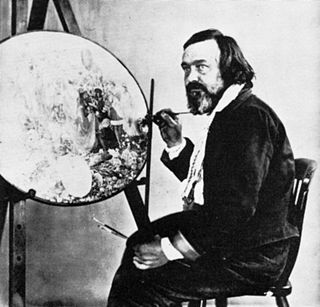
Richard Dadd was an English painter of the Victorian era, noted for his depictions of fairies and other supernatural subjects, Orientalist scenes, and enigmatic genre scenes, rendered with obsessively minuscule detail. Most of the works for which he is best known were created while he was a patient in Bethlem and Broadmoor hospitals.

Sir John Everett Millais, 1st Baronet was an English painter and illustrator who was one of the founders of the Pre-Raphaelite Brotherhood. He was a child prodigy who, aged eleven, became the youngest student to enter the Royal Academy Schools. The Pre-Raphaelite Brotherhood was founded at his family home in London, at 83 Gower Street. Millais became the most famous exponent of the style, his painting Christ in the House of His Parents (1849–50) generating considerable controversy, and he produced a picture that could serve as the embodiment of the historical and naturalist focus of the group, Ophelia, in 1851–52.

The Pre-Raphaelite Brotherhood was a group of English painters, poets, and art critics, founded in 1848 by William Holman Hunt, John Everett Millais, Dante Gabriel Rossetti, William Michael Rossetti, James Collinson, Frederic George Stephens and Thomas Woolner who formed a seven-member "Brotherhood" partly modelled on the Nazarene movement. The Brotherhood was only ever a loose association and their principles were shared by other artists of the time, including Ford Madox Brown, Arthur Hughes and Marie Spartali Stillman. Later followers of the principles of the Brotherhood included Edward Burne-Jones, William Morris and John William Waterhouse.

Sir Edward Coley Burne-Jones, 1st Baronet, was an English painter and designer associated with the Pre-Raphaelite Brotherhood's style and subject matter.

John William Waterhouse was an English painter known for working first in the Academic style and for then embracing the Pre-Raphaelite Brotherhood's style and subject matter. His paintings are known for their depictions of women from both ancient Greek mythology and Arthurian legend. A high proportion depict a single young and beautiful woman in a historical costume and setting, though there are some ventures into Orientalist painting and genre painting, still mostly featuring women.

William Powell Frith was an English painter specialising in genre subjects and panoramic narrative works of life in the Victorian era. He was elected to the Royal Academy in 1853, presenting The Sleeping Model as his Diploma work. He has been described as the "greatest British painter of the social scene since Hogarth".

The Art of the United Kingdom refers to all forms of visual art in or associated with the United Kingdom since the formation of the Kingdom of Great Britain in 1707 and encompasses English art, Scottish art, Welsh art and Irish art, and forms part of Western art history. During the 18th century, Britain began to reclaim the leading place England had previously played in European art during the Middle Ages, being especially strong in portraiture and landscape art.
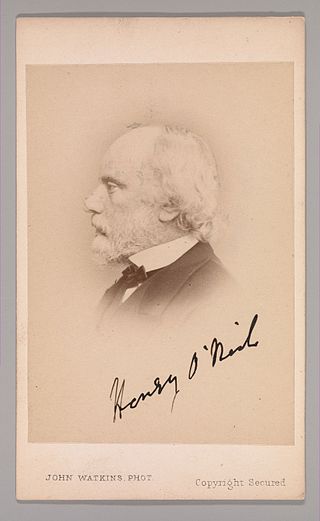
Henry Nelson O'Neil was a historical genre painter and minor Victorian writer. He worked primarily with historical and literary subjects, but his best-known paintings dealt with the Indian Mutiny. Eastward, Ho!, dated August 1857 but exhibited the following year, depicts the British troops embarking for India. A second painting, Home Again (1859), shows the troops returning to England. He also had popular successes with romantic scenes portraying the deaths of Mozart and Raphael, depicted as though mentally transported to heaven by their own religious art. In The Last Moments of Mozart the dying composer listens to singers performing part of his Requiem. The Last Moments of Raphael shows the painter contemplating the unseen figure of Christ in his Transfiguration.

Augustus Leopold Egg RA was a British Victorian artist, and member of The Clique best known for his modern triptych Past and Present (1858), which depicts the breakup of a middle-class Victorian family.

Edward Matthew Ward,, was a British painter who specialised in historical genre. He is best known for his murals in the Palace of Westminster depicting episodes in British history from the English Civil War to the Glorious Revolution.
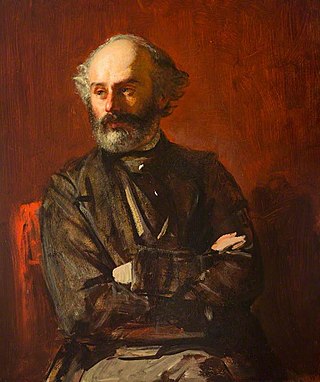
John Phillip was a Victorian era Scottish painter best known for his portrayals of Spanish life. He started painting these studies after a trip to Spain in 1851. He was nicknamed John 'Spanish' Phillip.

Alfred Elmore (1815–1881) was a British history and genre painter.

Frank Stone was an English painter. He was born in Manchester, and was entirely self-taught.

Philip Hermogenes Calderon was a British painter of French birth (mother) and Spanish (father) ancestry who initially worked in the Pre-Raphaelite style before moving towards historical genre. He was Keeper of the Royal Academy in London.
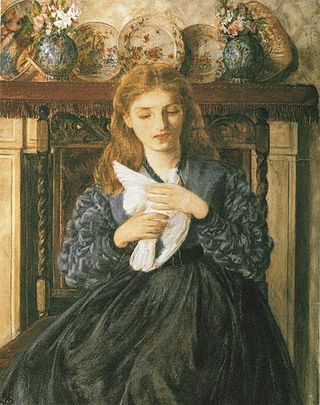
Rebecca Solomon was a 19th-century English Pre-Raphaelite draftsman, illustrator, engraver, and painter of social injustices. She is the second of three children who all became artists, in a prominent Jewish family.

Henry Stacy Marks was a British artist who took a particular interest in Shakespearean and medieval themes in his early career and later in decorative art depicting birds and ornithologists as well as landscapes. Most of his early works were oils but he also worked on murals and with watercolours. He was a founding member of the St John's Wood Clique and was well known for his humorous performances.
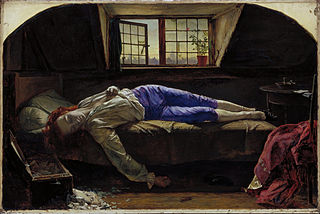
The Death of Chatterton is an oil painting on canvas, by the English Pre-Raphaelite painter Henry Wallis, now in Tate Britain, London. Two smaller versions, sketches or replicas, are possessed by the Birmingham Museum and Art Gallery and the Yale Center for British Art. The Tate painting measures 62.2 centimetres (24.5 in) by 93.3 centimetres (36.7 in), and was completed during 1856.

The Derby Day is a large oil painting showing a panoramic view of The Derby, painted by William Powell Frith over 15 months from 1856 to 1858. It has been described by Christie's as Frith's "undisputed masterpiece" and also "arguably the definitive example of Victorian modern-life genre."

Victorian painting refers to the distinctive styles of painting in the United Kingdom during the reign of Queen Victoria (1837–1901). Victoria's early reign was characterised by rapid industrial development and social and political change, which made the United Kingdom one of the most powerful and advanced nations in the world. Painting in the early years of her reign was dominated by the Royal Academy of Arts and by the theories of its first president, Joshua Reynolds. Reynolds and the academy were strongly influenced by the Italian Renaissance painter Raphael, and believed that it was the role of an artist to make the subject of their work appear as noble and idealised as possible. This had proved a successful approach for artists in the pre-industrial period, where the main subjects of artistic commissions were portraits of the nobility and military and historical scenes. By the time of Victoria's accession to the throne, this approach was coming to be seen as stale and outdated. The rise of the wealthy middle class had changed the art market, and a generation who had grown up in an industrial age believed in the importance of accuracy and attention to detail, and that the role of art was to reflect the world, not to idealise it.

Eastward Ho! is an 1858 genre painting by the British artist Henry Nelson O'Neil. It depicts troops departing to combat the Indian Mutiny embarking from Gravesend while their families bid them farewell. It was exhibited at the Royal Academy's Summer Exhibition in 1858. In 1859 it was displayed at Grundy's Repository in Liverpool. Today it is part of the collection of the Museum of London.




















